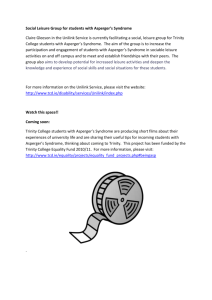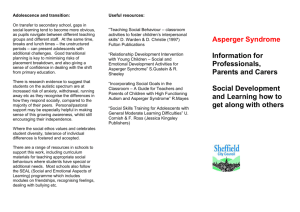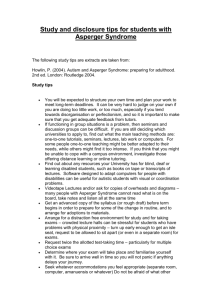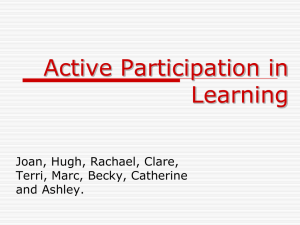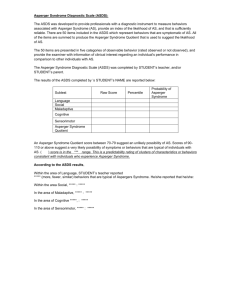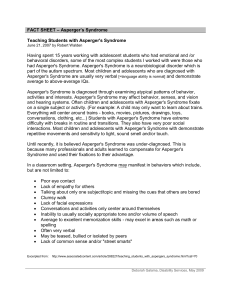Briefing for employers on Asperger Syndrome
advertisement
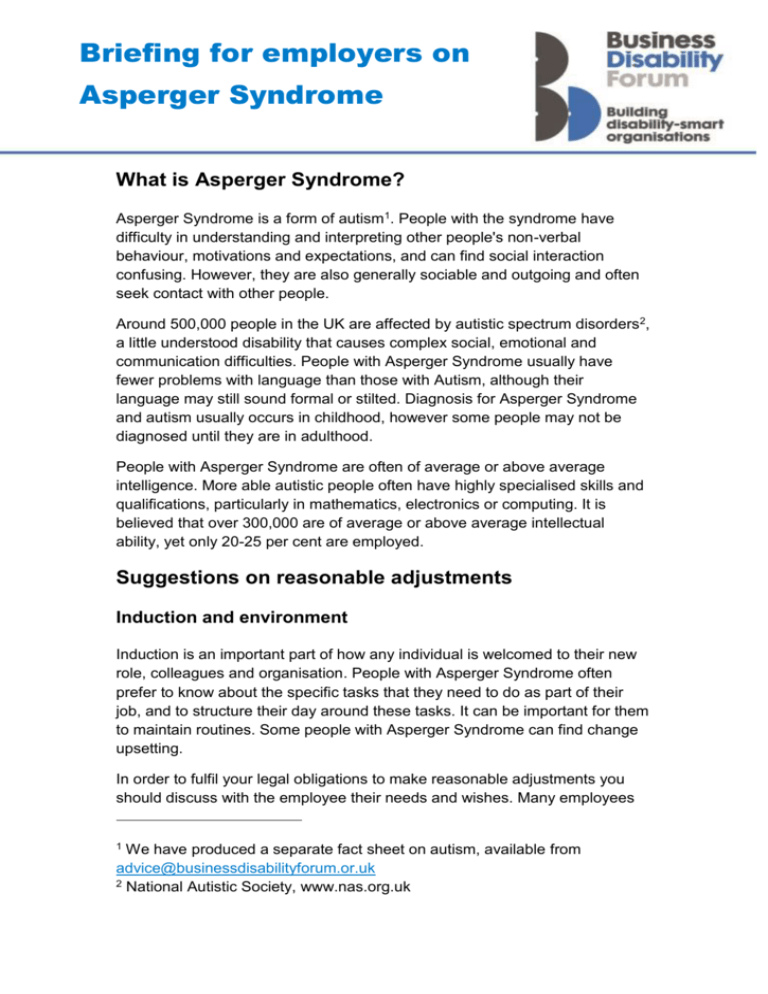
Briefing for employers on Asperger Syndrome What is Asperger Syndrome? Asperger Syndrome is a form of autism1. People with the syndrome have difficulty in understanding and interpreting other people's non-verbal behaviour, motivations and expectations, and can find social interaction confusing. However, they are also generally sociable and outgoing and often seek contact with other people. Around 500,000 people in the UK are affected by autistic spectrum disorders2, a little understood disability that causes complex social, emotional and communication difficulties. People with Asperger Syndrome usually have fewer problems with language than those with Autism, although their language may still sound formal or stilted. Diagnosis for Asperger Syndrome and autism usually occurs in childhood, however some people may not be diagnosed until they are in adulthood. People with Asperger Syndrome are often of average or above average intelligence. More able autistic people often have highly specialised skills and qualifications, particularly in mathematics, electronics or computing. It is believed that over 300,000 are of average or above average intellectual ability, yet only 20-25 per cent are employed. Suggestions on reasonable adjustments Induction and environment Induction is an important part of how any individual is welcomed to their new role, colleagues and organisation. People with Asperger Syndrome often prefer to know about the specific tasks that they need to do as part of their job, and to structure their day around these tasks. It can be important for them to maintain routines. Some people with Asperger Syndrome can find change upsetting. In order to fulfil your legal obligations to make reasonable adjustments you should discuss with the employee their needs and wishes. Many employees 1 We have produced a separate fact sheet on autism, available from advice@businessdisabilityforum.or.uk 2 National Autistic Society, www.nas.org.uk are extremely proactive in managing their own condition and may require few if any adjustments. Adjustments that might be needed include: Orientation around the building – it may take a while for a person with Asperger Syndrome to learn to navigate their way around the building. It might help to take the individual on practice journeys, allowing the person to make their own navigational map if they wish; Giving clear instructions about the role and the organisation so that the individual has the best possible understanding of what they are expected to do; Producing a timetable or pattern for the working day, including set times for arrival at work, breaks and lunch times; A support worker; Describing what to do with break times, e.g. read a newspaper or go for a walk, may reduce anxieties about what to do; Providing aids to help with organising job tasks, e.g. a notebook to write “to do lists”, a wall chart that visually highlights daily/monthly tasks. Communication People with Asperger Syndrome may speak fluently but can sound overprecise or formal. Reading another person’s body language (including facial expressions) can be difficult, as can noticing other people’s reactions. This may include, for example, not being able to tell if a person is too busy to talk. Adjustments that might be needed include: Avoiding the use of jokes, exaggerated language, turns of phrase, sarcasm, irony, metaphors, abstract or ambiguous statements; Keeping sentences short or using more direct language, being clear and concise; Being aware that some people may prefer responding to closed rather than open questions; Explaining and repeating requests clearly. 2 Workplace behaviour People with Asperger Syndrome may on occasion behave in ways that others regard as “strange” (e.g. pacing or talking to themselves) yet do their job satisfactorily. Some of this behaviour may be unintentionally directed towards fellow colleagues (e.g. reading information on colleagues’ desks without asking for permission). Adjustments that might be needed include: Securing fellow workers’ tolerance and understanding; If the behaviour needs to be challenged, tell the employee clearly that the behaviour is not appropriate, and ask them not to do it again; This may need to be repeated on several occasions if the action is repeated, as it may take time for the employee to learn that the behaviour is inappropriate. Anxiety Some people with Asperger Syndrome might experience anxiety if there are any changes to their work situation or routines. For example, arriving at work late due to transport delays or a computer screen going blank. As routine can be important, some people with Asperger Syndrome can feel distressed by unexpected events. Adjustments that might be needed include: Being able to speak to someone about such incidents (e.g. the line manager, or a named mentor) who can talk through the problem and assess whether an immediate solution can be found, focusing on the fact that a problem can be fixed; Re-focusing the individual on the job on hand; Minimising deadlines, as pressure can be unhelpful. Some people with Asperger Syndrome might work more slowly than expected. This is often because accuracy is maintained by the individual at the expense of speed through checking their work (output is often 100% accurate).Working as part of a team. Not all employees will be aware of the characteristics of Asperger Syndrome, or how to ensure that they communicate effectively with an individual. It is 3 important that managers are aware of what they can do to support an employee with autism. Adjustments that might be needed include: Provide training for managers and colleagues who work with an employee with Asperger Syndrome to secure fellow workers’ tolerance and understanding (this should only be done if the individual has given their consent to this information being disclosed); Plan any changes to a routine with the person with Asperger Syndrome well in advance of the change, with regular reminders of when it will happen and how it will affect that individual; Invite the individual to team social events, explaining why they should attend, and when and where it will be. If the event is during the working day, then ensure the employee is given time to prepare. Legal position Disability discrimination under the Equality Act 2010. Direct discrimination It is unlawful for an employer to treat a disabled job applicant, or employee, less favourably, simply because of their disability. This type of discrimination is known as direct discrimination. It is unlawful and cannot be justified. Discrimination arising from disability The Equality Act replaced disability-related discrimination in the Disability Discrimination Act with discrimination arising from disability which occurs when: An employer knows or could reasonably be expected to know that the person is disabled; The disabled person experiences unfavourable treatment which arises as a consequence of their disability. There is no requirement for a comparator i.e. the disabled person does not have to show that they have been treated or would have been treated less favourably than someone else. 4 An employer can justify detrimental treatment arising out of a disability if they can show that it is a proportionate means of achieving a legitimate aim. Indirect discrimination The Equality Act has introduced the new concept of indirect disability discrimination. Indirect discrimination occurs when a seemingly neutral provision, criterion or practice that applies to everyone places a group who share a characteristic e.g. a disability at a particular disadvantage. Indirect discrimination may be justified if it can be shown that the provision, criterion or practice is a proportionate means of achieving a legitimate aim. Reasonable adjustments An employer has a duty under the Equality Act to make reasonable adjustments (which includes providing auxiliary aids such as a support worker or information in alternative formats) to prevent a disabled employee from being placed at a substantial disadvantage by any physical feature of the premises, or by any provision, criteria or practice of the employer. The duty applies to all aspects of employment, including recruitment and selection, training, transfer, career development and retention and redundancy. Failure to make a reasonable adjustment to a policy procedure or practice, or to a physical feature of the workplace where this is placing a disabled person at a substantial disadvantage, is unlawful and cannot be justified. Examples of reasonable adjustments for people with dyslexia are given throughout this briefing. When deciding whether or not an adjustment is reasonable an employer should consider the: Effectiveness of the adjustment in preventing the disadvantage; Practicality of the adjustment; Financial and other costs of the adjustment and the extent of any disruption caused; Extent of the employer¹s financial or other resources; Availability to the employer of financial or other assistance to help. 5 Make an adjustment, for example through the Access to Work scheme and the support of Jobcentre Plus. Equality Duty Public authorities and those carrying out public functions are required by the Equality Act to promote equality of opportunity for disabled people. This includes ensuring that third parties, such as recruitment agencies who provide services to the authority, do not discriminate against disabled people and that they positively encourage disabled candidates to apply for jobs within the authority. The duty also means that authorities need to think in advance about the needs of both disabled employees and potential disabled employees. Authorities should bear this in mind when reading this briefing. As well as the Equality Act, there is also a “statutory” Code of Practice on Employment and Occupation. “Statutory” means that it is produced under the legislation; it is admissible as evidence and must be taken into account by courts and tribunals where relevant. References are made in this briefing to the Code. 6 For more information contact: National Autistic Society 393 City Road London EC1V 1NG Tel: 020 7833 2299 Helpline: 0845 070 4004 Fax: 020 7833 9666 Email: nas@nas.org.uk Website: www.nas.org.uk Or Business Disability Forum Nutmeg House | 60 Gainsford Street | London | SE1 2NY Tel: +44-20-7403-3020 | Textphone: +44-20-7403-0040 Email: advice@businessdisabilityforum.org.uk Web: http://businessdisabilityforum.org.uk This publication and the information contained therein are subject to copyright and remain the property of Business Disability Forum. They are for reference only and must not be reproduced, copied or distributed as a whole or in part without prior permission, apart from internal distribution within the original recipient’s organisation. The information provided in this publication is for guidance only and Business Disability Forum accepts no liability for any actions, or consequences of actions, arising from this information. Business Disability Forum is committed to ensuring that all its products and services are as accessible as possible to everyone, including disabled people. If you wish to discuss anything with regard to accessibility, please contact us as set-out above. 7

